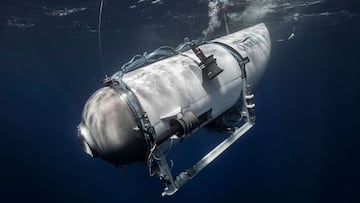The 5 theories about what could have caused the ‘catastrophic implosion’ on the Titan
The Titan submersible suffered a ‘catastrophic implosion’, according to the US Coast Guard. Here are some theories on what could have caused the collapse.

On Thursday, the United States Coast Guard found several pieces of debris near the Titanic. They later confirmed that the wreckage belonged to the OceanGate Expeditions submersible Titan. The USCG said the evidence showed that the vessel experienced a catastrophic implosion.
The Coast Guard said the implosion occurred after a loss of pressure in Titan’s chamber, meaning it would have been a rapid implosion with no chance of survival. Shortly thereafter, OceanGate announced that all five crew members had unfortunately passed away.
Crew members included Stockton Rush, CEO and co-founder of OceanGate, British businessman Hamish Harding, Pakistani businessman Shahzada Dawood and his son Suleman Dawood, and French explorer Paul-Henry Nargeolet.
What is an implosion?
An implosion refers to the sudden inward collapse of the vessel, which would have been under immense pressure in the depths where Titan plunged.
It’s unclear where or how deep the Titan was when the implosion occurred, but the Titanic’s wreckage lies nearly 13,000 feet (nearly 4,000 meters) below sea level. The submersible was approximately one hour and 45 minutes into its approximately two-hour descent when it lost contact.
Separately, a US official said Thursday that a Navy acoustic system detected an “anomaly consistent with an implosion or explosion” in the area where communications with the Titan were lost.
The 5 theories about what could have caused the ‘catastrophic implosion’ on the Titan
Fault in the hatch or a defect in the pressure hull
A former Royal Navy submarine captain has explained the possible reasons for the catastrophic implosion suffered by the Titan submersible. Former captain Ryan Ramsey told Sky News he believes one of two things happened:
The bolted hatch used to seal the crew from the outside suffered a failure causing the hull to collapse, or that the pressure hull itself had a defect which caused it to fracture from the pressure and ended with the same result.
Water pressure
Titan’s abrupt demise was apparently caused by the same deep-sea forces that make expeditions like this so rare, according to Paul White, a professor at the University of Southampton in England, who specializes in acoustics and underwater forces.
In the depths of the Titanic, at about 12,500 feet down, the water pressure is nearly 400 times greater than at the ocean surface, so some 6,000 pounds would have been pressing on every square inch of Titan’s exterior. The pressure would have overcome the resistance of the Titan’s hull, deforming its structure.
Pressure hull failure
Stefan Williams, a professor of marine robotics at the University of Sydney, shared in a blog post that a failure in the Titan’s hull could have caused an implosion, as the vessel gave way to the high pressure of the depths of the sea.
Roderick Smith, professor of engineering at Imperial College London, also noted that the implosion was likely due to “pressure hull failure” but that the debris will need to be recovered for a full investigation to be carried out. And even then, it may not be easy to identify the cause.
Structural failures and lack of supervision
Director James Cameron, a deep-sea explorer who has dived more than 30 times in all to visit the Titanic wreckage, said he guessed critics were right to warn that a carbon fiberglass and titanium hull and would allow delamination and microscopic water ingress, leading to progressive failure over time.
On possible structural failures and lack of oversight, Guillermo Söhnlein, co-founder of OceanGate, said it was too early to say what happened to the Titan, adding that it was difficult to formulate global regulations for submersibles designed to go that deep.






